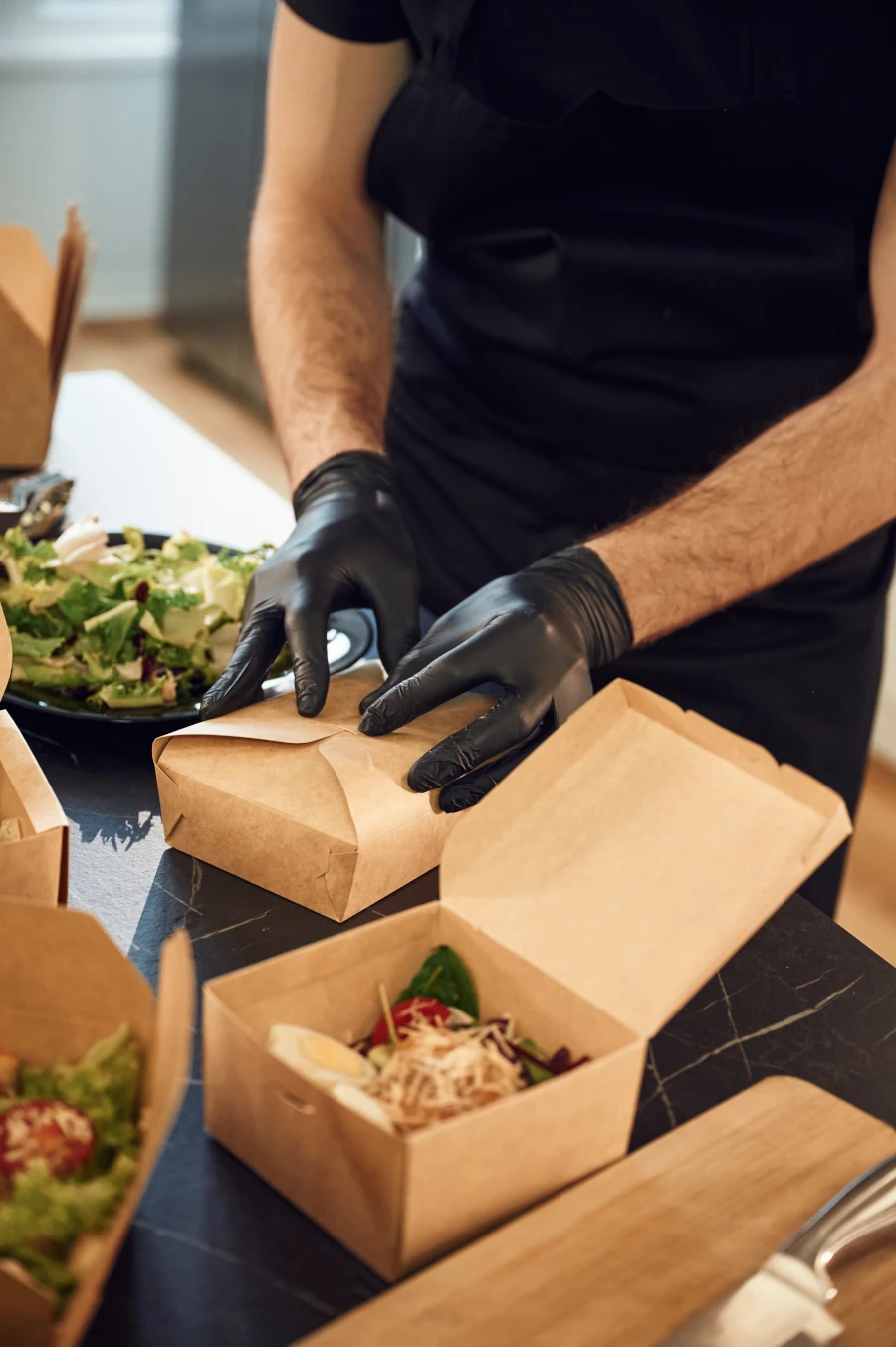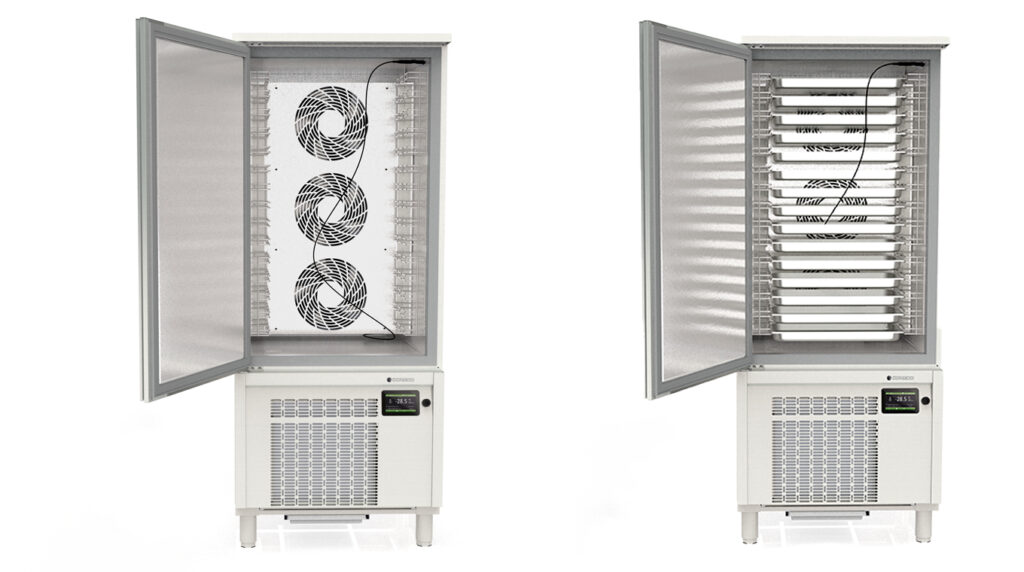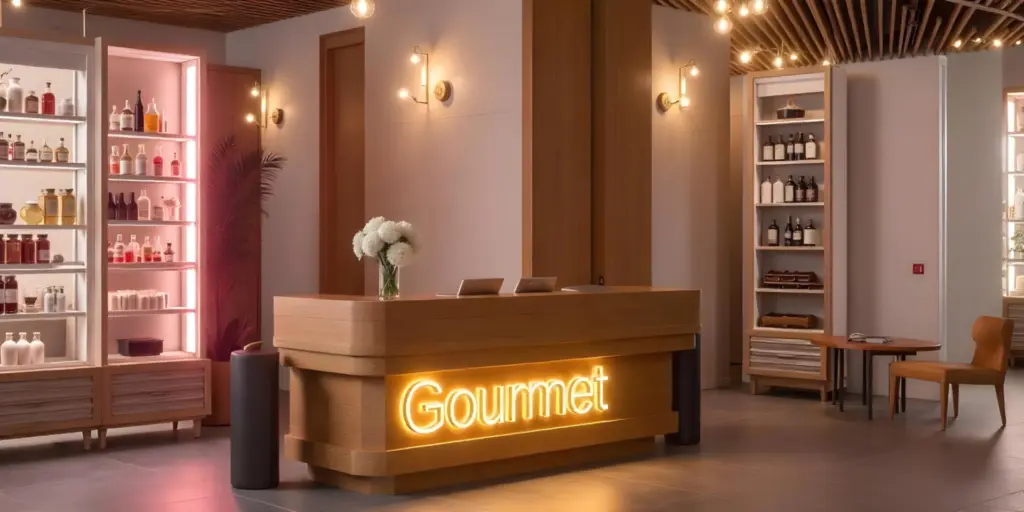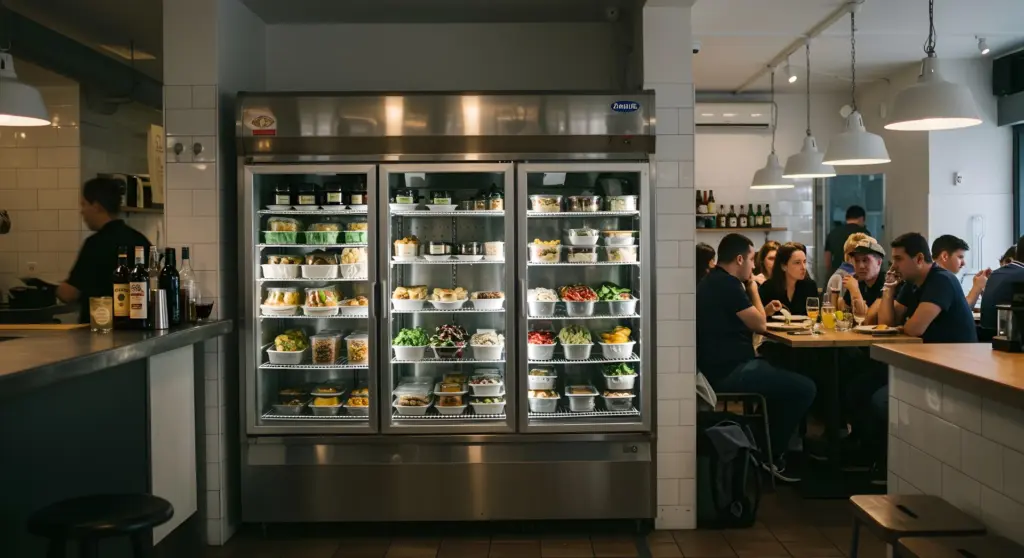Welcome back to our blog. The digitisation and growth of the delivery have driven a radical transformation in the hospitality industry, giving way to the rise of the dark kitchens o ghost kitchens. This model, based on the production of food exclusively for home delivery, has revolutionised the way restaurants operate, optimising the way in which food is produced. operational costs, logistical efficiency and scalability.
The Exponential Growth of the Delivery Market and its Impact on the Catering Industry
The global food delivery market continues to expand, transforming the way consumers access multiple gastronomic offerings. According to the study by The Brainy Insightsthe sector reached a value of 242.09 billion in 2023with projections indicating that will exceed USD 746.55 billion by 2033The growth has been sustained, with a compound annual growth rate (CAGR) of the 11,92% on 2024 y 2033.
This growth is no coincidence. Factors such as the increase in the use of smartphones, the demand for convenience dining solutions and the digitisation of the dining experience are driving the industry to unprecedented levels. The improvement in network connectivity and delivery software innovation have allowed the platforms to evolve, offering more intuitive interfaces, optimised delivery times and a wider range of dining options.
Asia-Pacific: The Engine of Global Growth in Delivery
Within the global market, the Asia-Pacific has established itself as the absolute leader in the delivery sectorwith a share of 41.5% in total market revenues in 2023. Countries such as China, Japan, India and South Korea have experienced a rapid growth in demand for home-delivered fooddriven by changes in food preferences, rapid urbanisation, rising per capita incomes and the rise of highly efficient delivery platforms.
The business model of consumer platform led the sector, accounting for 68% of market share in 2023. For their part, as regards the access channelsthe mobile applications dominated the sector with a share of 82%thanks to its ease of use, speed and accessibility.
The Future of Delivery and its Relationship to Dark Kitchens
These data reflect a irreversible trend in consumer habits. The convenience, technology and personalisation of service have changed the expectations of customers, consolidating the model of dark kitchens as the perfect ally to capitalise on this evolution..
The growing demand for home-delivered food requires optimised infrastructurewhere production efficiency, proper preservation of ingredients and reduction of waste play a crucial role in the profitability of the business. Coreco Gourmetwith its wide range of blast chillers, Coreco Coldrooms cold rooms and refrigerated display cabinetsoffers refrigeration solutions specifically designed to maximise operations in dark kitchens and delivery businesses.
Data on the Spanish delivery market in 2024
The delivery market in Spain has also experienced significant growth in 2024, according to various studies and data provided by delivery platforms and consultancies.
According to the XII edition of the 'Gastrómetro', elaborated by Just Eat, the home delivery and online shopping basket market in Spain will close 2024 with revenues close to 8,000 million euros, which represents an increase of almost 20% compared to 2023. Specifically, the online meal delivery market will exceed €1.29 billion, while the online shopping basket will amount to €5.99 billion.
Uber Eats reports a 40% growth in the number of food delivery orders in Spain during 2024 compared to the previous year. Major cities such as Madrid and Valencia have recorded above the national average, consolidating themselves as epicentres of this growth..
In terms of consumption trends, although American-style food remains the most popular category with a growth of more than 50%, there has been a significant increase in other options. For example, kebabs, burritos and focaccias have experienced growth of up to 80% in urban areas such as Madrid. In addition, healthy food is becoming one of the favourite options in cities such as Madrid, Barcelona and Seville.
Consumption habits have also evolved. While weekends, especially Sundays, remain the peak times for demand, a significant increase in weekday orders has been observed. In particular, demand for breakfasts increased by 30% over the past year.
Looking ahead, Statista, the German data collection platform, forecasts that the market for the home shopping basket will grow by 45% by 2028, while food delivery is expected to grow by 27%. The business is estimated to reach 11.3 billion euros by 2028, divided into 1.6 billion euros for food delivery and 8.71 billion euros for the shopping basket.
These data reflect a clear trend towards convenience and flexibility in the consumption habits of Spaniards, driven by the convenience and time savings provided by the delivery service.
Types of Dark Kitchens: Business Models and Characteristics
The food delivery industry is experiencing unprecedented growth. Driven by digitisation, pandemic inertia and consumers' growing preference for at-home dining experiences, the home-delivery market is experiencing unprecedented growth. delivery can overcome 160 billion euros by 2025, according to BusinessWire.
This boom has given way to a business model that is transforming the catering industry: the Dark Kitchens (also known as Ghost Kitchens o Ghost Kitchens). These kitchens operate without on-site service, designed exclusively to prepare orders for home delivery.
But not all dark kitchens are the same. There are six main structureseach with unique features, advantages and challenges.
Types of Dark Kitchens: Business Models and Characteristics
The concept of dark kitchen has evolved rapidly in recent years, adapting to the needs of a rapidly changing market. delivery increasingly demanding. What they all have in common, however, is the absence of a physical space for consumption on the premises, there are different models of dark kitchenseach designed to optimise costs, logistics and operational efficiency according to the type of gastronomic business.
Below, we will look at the main ones dark kitchens business modelsThe following are their characteristics, advantages and cases in which they may be the best option.
1. Dark Kitchen Traditional: One operator, one concept
This is the most basic and widespread model. It is a kitchen used by a single brand or restaurantwhose only sales channel is home delivery.
Key features:
A single operator manages the kitchen.
✅ The restaurant no direct contact with the customerThe orders arrive via delivery platforms.
✅ Requires a lower investment compared to a traditional restaurant.
✅ It may be independent or within a shared space with other dark kitchens.
Advantages:
✔️ Reduced operating costs: There is no need for waiters or furniture for customers.
✔️ Easy management: By focusing on a single concept, the operation is simpler.
✔️ Scalability: More locations can be opened without the need for large investments.
Who is it ideal for?
📌 Restaurants that already exist and are looking to expand without opening a new physical location.
📌 Gastronomic entrepreneurs who want to try out a new culinary concept without assuming the high costs of a traditional restaurant.
2. Dark Kitchen Multibrand: Multiple brands in one space
In this model, a single company operates various food brands within the same kitchen, optimising resources and production.
Key features:
One operator manages different brands with different menus.
Each brand is marketed independently on delivery platforms.
✅ Shared equipment, ingredients and personnelmaximising operational efficiency.
✅ Allows testing different gastronomic concepts without the need for multiple premises.
Advantages:
✔️ Increased profitability: The same kitchen team produces for several brands.
✔️ Flexibility: Brands can be added or modified according to market demand.
✔️ Cost reduction: By sharing infrastructure and staff, operational costs are optimised.
Who is it ideal for?
📌 Restaurant companies that want to expand their catalogue without opening new physical premises.
📌 Traditional restaurants wishing to diversify their offer and increase their turnover by delivery.
🔹 Example of success: A business that manages burger, sushi and taco brands from the same kitchen, operating with different visual identities but sharing resources.
3. Dark Kitchen with on-site pick-up: The hybrid model
Although dark kitchens usually operate exclusively for the purpose of deliverysome have adopted the model of "takeaway or collection from the premises.
Key features:
Customers can pick up their order at the shop.
✅ Reduces dependence on delivery platforms.
It is an attractive option for customers who prefer to avoid shipping costs.
Advantages:
✔️ Higher profit margin: Delivery platform fees are reduced.
✔️ Better customer experience: Some customers prefer to pick up the food themselves.
✔️ Flexibility in business strategy: It allows you to attract local customers without losing the dark kitchen structure.
Who is it ideal for?
📌 Businesses located in urban areas with high demand for take-away orders.
📌 Brands that want maintaining contact with the client without opening a traditional restaurant.
4. Aggregator-owned Dark Kitchen: Delivery platform cooking spaces
Some platforms such as Uber Eats, Glovo, Deliveroo or Just Eats have developed their own shared kitchenswhere they rent space to different operators.
Key features:
They are equipped and ready to operate, eliminating the need for infrastructure investment.
The restaurants rent the kitchen and use the delivery platform to distribute their products.
✅ They are located in strategic areas to optimise logistics and reduce delivery times.
Advantages:
✔️ Lower initial investment: There is no need to buy equipment or to set up premises.
✔️ Quick start-up: You can start operating in a matter of weeks.
✔️ Strategic location: They are designed to maximising logistics efficiency delivery.
Who is it ideal for?
📌 Restaurants and brands looking to expand rapidly in new markets without infrastructure investment.
📌 Companies that prefer to focus solely on food production without worrying about space management.
🔹 Example of success: A restaurant that opens in an Uber Eats kitchen in a new city without needing to rent its own premises.
5. Outsourced Dark Kitchen: Outsourced Production and Cost Optimisation
In this model, the most of the production process is outsourcedThe final phase of preparation and packaging in the kitchen is left to the kitchen.
Key features:
The kitchen only finishes and packages the dishes, reducing production times.
✅ The production of ingredients or pre-prepared dishes.
✅ May include partnerships with food production chains or specialised suppliers.
Advantages:
✔️ Increased efficiency: Production times are reduced.
✔️ Fewer staff required: Fewer chefs and operators are required.
✔️ Cost optimisation: Costs for ingredients and preparation are minimised.
Who is it ideal for?
📌 Fast food companies or companies with a high volume of orders.
📌 Brands looking for high profitability with optimised production.
🔹 Example of success: A health food company that outsources the production of its packaged meals and only does the final assembly in the dark kitchen.
So which Dark Kitchen model is the most profitable?
Each dark kitchen model has its own advantages and challenges, and the choice will depend on key factors such as investment, type of cuisine, volume of orders and business strategy.
🔹 If you are looking to reduce costs and operate with flexibilitythe traditional dark kitchen is an ideal option.
🔹 If you want to scale the business with several brandsthe dark kitchen multi-brand allows resources to be optimised.
🔹 If you prefer an easier entry to the marketthe dark kitchens of aggregators offer a quick and cost-effective solution.
🔹 If you want to minimise operating coststhe dark kitchen subcontracted allows for a more efficient operation.
Regardless of the model chosen, having the appropriate equipment is essential to ensure the quality and profitability of the business. Coreco offers refrigeration and preservation solutions adapted to every type of dark kitchen, from blast chillers to high-performance cold rooms..

Key factors for choosing the ideal Dark Kitchen model
The success of a dark kitchen depends to a large extent on the choosing the right business model. Not all phantom kitchens work in the same way, and the decision should be based on strategic, operational and financial factors that are aligned with business objectives.
Here we present the key factors you should analyse before choosing the type of dark kitchen that best suits your gastronomic business.
Budget and initial investment
The available capital is a determining factor in the selection of the dark kitchen model. It is not the same to rent a kitchen ready to operate within an aggregator than to set up a own infrastructure with specialised equipment. The numbers are purely speculative and come from averages. They are intended to serve as an approximation and should not be taken as anything else.
| Dark Kitchen model | Estimated Investment | Approximate Monthly Costs |
|---|---|---|
| Dark Kitchen Traditional | 40.000 – 80.000 € | 3.000 – 5.000 € |
| Dark Kitchen Multibrand | 70.000 – 120.000 € | 5.000 – 8.000 € |
| Dark Kitchen in Aggregator | 5.000 – 15.000 € | 2.000 – 4.000 € |
| Dark Kitchen Subcontracted | 20.000 – 50.000 € | 3.000 – 6.000 € |
🔹 If you are on a tight budgeta dark kitchen in an aggregator may be the most viable option.
🔹 If you are looking for a more cost-effective model in the long termsetting up your own dark kitchen allows you to have full control of the operation.
2. Type of cuisine and gastronomic offer
The dark kitchen model should be compatible with the type of cuisine you plan to offer. Operating a hamburger restaurant is not the same as operating a fine dining restaurant.
| Type of cuisine | Most Suitable Model | Key Requirements |
|---|---|---|
| Fast food (burgers, pizzas, tacos) | Dark Kitchen Traditional or in Aggregator | Fast, high-volume production. |
| Haute cuisine (gourmet cuisine, elaborate dishes) | Dark Kitchen Premium or Multibrand | Advanced equipment, optimal maintenance. |
| Healthy food (poke, salads, vegan) | Dark Kitchen Multibrand or Outsourced | Fresh ingredients, efficient stock rotation. |
| International food (sushi, thai, mexican) | Dark Kitchen Multibrand | Brand diversification, differentiated processes. |
🔹 For gourmet businesses, it is essential to invest in premium equipment. as Coreco temperature controllers y high-performance cold rooms.
🔹 For fast food, a dark kitchen in an aggregator is a quick and low-risk option..
3. Location and delivery area
The geographical point where the dark kitchen is installed directly affects delivery times and delivery efficiency.
Factors to consider in the choice of location:
✅ Population density: Areas with high demand for delivery, such as urban centres.
✅ Proximity to target customers: Choose a location close to the main consumers.
✅ Rental costs: Premium zones may be more expensive, but guarantee higher demand.
✅ Availability of delivery drivers: Areas with the highest number of active riders on delivery platforms.
📌 Example of a location strategy:
- If your brand focuses on premium dishesit is advisable to be close to affluent residential areas.
- For fast foodIn the case of the university or commercial areas, it is key to be located in areas with high order turnover.
4. Dependence on delivery platforms or own channel
A key factor is to decide if the model will rely exclusively on delivery platforms or whether a direct sales channel.
✅ Dark kitchens in aggregators (Uber Eats, Glovo, Just Eat) depend on these platforms, which reduces control over the customer relationship and tariffs.
✅ Dark kitchens own allow for the development of a most profitable independent brand.
🔹 To minimise commissionsit is recommended to offer incentives for customers to order directly via the own website (discounts, promotions, free shipping).
5. Production Capacity and Scalability
If the business has the potential for growth, it is important to choose a model that allows for easy scalability.
✔️ A multi-brand dark kitchen allows you to expand with new concepts without opening more outlets.
✔️ Aggregator facilitates rapid expansion in different cities at low risk.
✔️ If the objective is to create a franchise, a traditional dark kitchen with its own branding is the best option..
6. Health Regulations and Standards
Dark kitchens must comply with strict food safety regulations. Before choosing a model, make sure you have:
📌 Health licences and permits.
📌 Efficient and approved cooling systems.
📌 Equipment complying with food safety standards (Coreco Coldrooms, blast chillers).
Coreco offers solutions tailored to each business model to guarantee regulatory compliance and energy efficiency.
7. Technology and Equipment
Regardless of the dark kitchen model chosen, it is important to have state-of-the-art technology allows for improved operational efficiency.
Essential equipment for any dark kitchen:
🔹 Coreco Temperature ChillersEssential for storing ingredients in the safest possible way.
🔹 Coreco Coldrooms cold roomsOptimise the storage of fresh produce.
🔹 Order and stock control systemsAutomation to improve production times.
📌 Investing in quality equipment ensures lower operating costs and higher production efficiency.
Conclusion: How to Choose the Most Profitable Dark Kitchen Model?
Choosing the right dark kitchen model is a process that requires assessing multiple strategic factors.
🔹 If you have a limited budgetthe best is a aggregator.
🔹 If you are looking for flexibility and growtha multi-brand will allow you to scale your business.
🔹 If product quality is a prioritya dark kitchen gourmet with premium equipment is the best choice.
🔹 If you want to maximise long-term profitabilityis better to operate a in-house kitchen with full process control.
Coreco offers refrigeration and preservation solutions designed for every type of dark kitchen.The costs, energy efficiency and final product quality.
Do Dark Kitchens have a future?
The answer is yes, and with great projection. For 2026The market for home-delivered food is expected to exceed 500 billion euroswith an annual growth of 8,29%.
One of the reasons for this growth is the change in consumer habits. Millennials and Generation Z are the main driving force behind this transformation, due to their:
✔️ Preference for digital experiences and convenience.
✔️ High purchasing power and spending on online orders.
✔️ Social media impactby rating reviews and sharing opinions.
The dark kitchens allow gastronomic businesses to adapt to these changes in consumptionThe new system offers an efficient, scalable and cost-effective response.
Global Dark Kitchens Market Growth
Growth projections are impressive:
📌 By 2030, dark kitchens could reach a global market value of one trillion euros..
📌 En Spainthe market for dark kitchens was valued at 928.22 million by 2024with a growth of 4,5% per year until 2034where it is estimated to reach 1,379 million.
📌 En United Statesthere are more than 1,500 dark kitchens.
📌 United Kingdom operates approximately 750 ghost kitchens.
📌 India leads in Asia with more than 3.500 dark kitchens.
📌 Chinawith more than 7.500 dark kitchensis the country with the highest penetration of this model.
It is estimated that by 2030the dark kitchens will represent the 50% of the global takeaway market.
How to Set Up a Dark Kitchen: Key Steps
The process of assembly of a ghost kitchen involves making strategic decisions on location, equipment and operational management.
1. Choice of Concept
Define whether to operate single or multiple brands under the same roof.
2. Location and Space
The dark kitchens should be located in strategic areas with high order density and good logistical connectivity.
3. Investment in Equipment
The professional equipment is the key to success. To ensure efficiency and food safetyis recommended:
🔹 Coreco Temperature Chillersessential to preserve the quality of the ingredients.
🔹 Coreco Coldrooms cold roomsperfect for efficient storage.
🔹 Refrigerated display cabinetsideal for keeping ingredients fresh before plating.
4. Licensing and Regulations
Comply with health and food safety regulations is indispensable for the legality of the business.
5. Digital Strategy and Marketing
To stand out in a saturated market, it is key to develop:
✔️ Attractive and differential branding.
✔️ SEO positioning strategies to appear in customer searches.
✔️ Active social networks and digital advertising to attract new consumers.
Coreco: The Cooling Solution for Dark Kitchens
The efficiency and profitability of a dark kitchen depend to a large extent on its infrastructure and equipment.
Why trust Coreco for your ghost kitchen?
✅ Temperature Chillers to preserve ingredients in optimal conditions.
✅ Coreco Coldrooms cold rooms for efficient storage.
✅ Refrigerated display cabinets for high quality ingredients in gourmet kitchens.
✅ Energy-efficient equipmentreducing operating costs.
🔹 Consultation with our specialised team and discover how to optimise your business with the best technology in professional refrigeration.
📍 Find out more:
🔗 Coreco Gourmet
🔗 Coreco Coldrooms 🚀
So are Dark Kitchens the Future of Delivery?
The dark kitchens have ceased to be a trend and have become a consolidated reality in modern catering.
If you are looking for a scalable, profitable business adapted to the digital agesetting up a dark kitchen can be the best investment. With the support of Coreco Gourmetyou will have access to the best equipment to ensure operational efficiency, sustainability and commercial success.
💡 Start today and equip your kitchen with Coreco Gourmet solutions to grow your business in the gourmet delivery sector! 🚀









